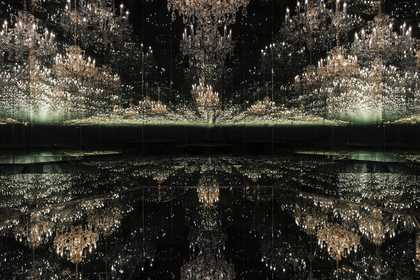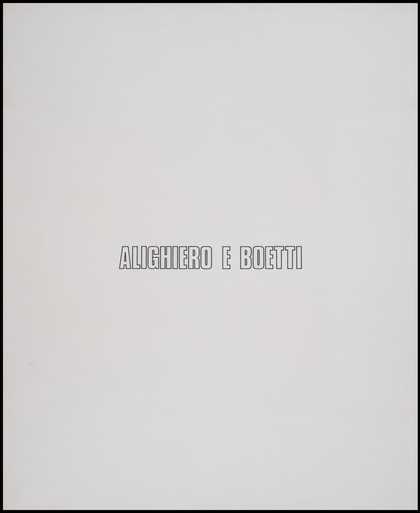Led by Richard Martin and Lucy Scholes
Please note: The first session on Saturday 25 February will take place in the Starr Auditorium, ╔½┐ž┤½├Į, 10.30ŌĆō15.00.
In contemporary society, we are constantly urged to participate, to engage and to get involved. To be apathetic ŌĆō about politics or culture ŌĆō is regarded as irresponsible, indulgent and even dangerous. Such extortions are accompanied by widespread disaffection and feelings of social alienation. Yet, from Greek philosophers through nineteenth-century novelists to contemporary artists, apathy has held its own creative possibilities.
These competing ideas lie at the heart of the fascinating apathy complex that will be explored in this new six-week course. WeŌĆÖll take a thoroughly multi-disciplinary approach, placing film, literature and critical theory alongside works by modern and contemporary artists represented in the Tate collection. WeŌĆÖll also discuss how the exhibitions of Yayoi Kusama and Alighiero Boetti might contribute to the debate.
Entry to the Yayoi Kusama exhibition at ╔½┐ž┤½├Į included in the courseŌĆÖs ticket price.
About the course
Throughout the course, weŌĆÖll look at the formal problems of representation that the concept of apathy raises and how the role of the artist might change in response. WeŌĆÖll examine related notions such as boredom and disaffection, power and resistance, objectivity and excess. At the heart of our discussions will be the relationship between the individual and society, especially in times of economic uncertainty.
Each weekly session will explore a different perspective on our central theme, with film clips, illustrated presentations and short handouts offering suggestive directions of enquiry. No prior knowledge is needed to take part in this course, though participants will be encouraged to engage with a wide variety of material and to discuss their own interpretations in a warm and supportive setting.
While tickets to the Yayoi Kusama exhibition at ╔½┐ž┤½├Į are included in the course price, those attending will be expected to purchase Herman MelvilleŌĆÖs novella Bartleby, the Scrivener.
Classes will ordinarily begin with a short illustrated lecture on the main themes of the week, with class discussion ŌĆō in small break-out groups and as a whole ŌĆō forming the majority of each session.
Sessions
Week 1 (25 February), 10.30 ŌĆō 15.00, Starr Auditorium, ╔½┐ž┤½├Į╠²
Diagnosis
This extended first session (which will include a break for lunch) introduces some historical definitions of apathy, from Greek philosophy to the present, that inform our modern condition. WeŌĆÖll then enjoy a screening and discussion of Lars von TrierŌĆÖs fascinating film Melancholia (2011), as a specific contemporary case study of anxiety and depression. In a time of economic and social strife, Von Trier encourages us to consider a broader question: what might be the appropriate response to apocalypse?
Class Screening: Lars von Trier (dir.), Melancholia (2011).
Further References: Todd Haynes (dir.), Safe (1995); Ole Christian Madsen (dir.), KiraŌĆÖs Reason ŌĆō A Love Story (2001); Lars von Trier (dir.), The Idiots (1998) and Antichrist (2009); Thomas Vinterberg (dir.), Festern (1998).
Week 2 (3 March), 10.30 ŌĆō 13.00, Seminar Room, ╔½┐ž┤½├Į╠²
Boredom
This session will explore the concept of boredom and its relationship to apathy. We will focus on three key areas: the childŌĆÖs exasperation at having nothing to do; classic images of adolescent lethargy; and finally, from Madame Bovary to the suburbanites in Richard YatesŌĆÖs fiction, adults who become trapped by routine. Taking our lead from Peter TooheyŌĆÖs recent book Boredom: A Lively History, we will ultimately ask why it is that chronic boredom so often manifests itself in extreme action ŌĆō in the form of anger, violence, risk-taking, sensation-seeking, substance abuse or paranoia.
References:╠²
Film: Michelangelo Antonioni (dir.), │óŌĆÖe│”▒¶Š▒▓§▓§▒ (1962); Larry Clark (dir.), Kids (1995); Sofia Coppola (dir.), The Virgin Suicides (1999) and Somewhere (2010); C├®dric Kahn (dir.), │óŌĆÖe▓į▓į│▄Š▒ (1998); Jonathan Kaplan (dir.), Over the Edge (1979); Mathieu Kassovitz (dir.), La Haine (1995); Terence Malick (dir.), Badlands (1973); Andrei Tarkovsky (dir.), Stalker (1979).
Literature: Gustave Flaubert, Madame Bovary (1856); Elizabeth Goodstein, Experience Without Qualities: Boredom and Modernity (2005); Adam Phillips, ŌĆśOn Being BoredŌĆÖ (1994); Patricia Meyer Spacks, Boredom: The Literary History of a State of Mind (1995); Peter Toohey, Boredom: A Lively History (2011); Oscar Wilde, The Picture of Dorian Gray (1891); Richard Yates, various texts.
Week 3 (10 March) 10.30 ŌĆō 13.00, Seminar Room, ╔½┐ž┤½├Į╠²
Repetition
For artists such as Alighiero Boetti, Daniel Buren, Donald Judd, Sol LeWitt and Bridget Riley, repetition has proved a productive and inspirational strategy. Yet, repetition ŌĆō especially in the workplace ŌĆō is often considered to be a common cause of apathy. In this class, weŌĆÖll examine the rhythms of modern work, from industrial labour to office boredom. Our guiding text will be Herman MelvilleŌĆÖs Bartleby, the Scrivener 1853, an influential tale for many philosophers and political theorists. When it comes to the tedious duties of employment, BartlebyŌĆÖs ŌĆśI would prefer not toŌĆÖ is a powerful form of passive resistance. The psychological states explored in Yayoi KusamaŌĆÖs work will provide us with additional perspectives on obsession, repetition and artistic practice.
Core Text: Bartleby, the Scrivener Herman Melville 1853.
Class Visit: Yayoi Kusama exhibition at ╔½┐ž┤½├Į.
Further References: Chantal Akerman (dir.), Saute ma Ville (1968); Simon Critchley, Infinitely Demanding (2007); Joshua Ferris, Then We Came to the End (2007); Michael Hardt and Antonio Negri, Empire (2000); David Foster Wallace, The Pale King (2011); Slavoj ┼Įi┼Šek, The Parallax View (2006) and Violence (2008).
╔½┐ž┤½├Į Collection: Level 5: Energy and Process, Room 10: Sculpture from the Janet Wolfson de Botton Gift; Level 5, States of Flux, Room 5: Bridget Riley.
Week 4 (17 March), 10.30 ŌĆō 13.00, Seminar Room, ╔½┐ž┤½├Į╠²
Rebellion
What is the relationship between apathy and power? Does ideological consensus lead to low turnouts at the ballot box? What forms of political ŌĆśactionŌĆÖ are most effective? In this class, weŌĆÖll discuss dictatorships and democracies, revolutionary actors and conscientious objectors, in a survey of apathyŌĆÖs vital political implications. The notion of public space ŌĆō in both its physical and symbolic form ŌĆō will be of particular importance in teasing out the complex relationship between the individual and society. Recent political events, from London to Athens, offer a compelling context for our discussions.
References: Ken Loach (dir.), Days of Hope (1975); Jacqueline Rose, ŌĆśApathy and Accountability: South AfricaŌĆÖs Truth and Reconciliation CommissionŌĆÖ (2002); Jos├® Saramago, Seeing (2004); Renata Salecl, Choice (2010); Bela Tarr (dir.), Damnation (1988).
Week 5 (24 March), 10.30 ŌĆō 13.00, Seminar Room, ╔½┐ž┤½├Į╠²
Excess
If one definition of apathy in the Oxford English Dictionary is ŌĆśindolence of mind, indifference to what is calculated to move the feelings, or to excite interest or action,ŌĆÖ this session will explicitly examine how too much of something ŌĆō be it money, sex, food or power ŌĆō can dull the senses, ultimately inducing an apathetic response. We will analyse historical periods closely associated with a sense of excess, such as Marie AntoinetteŌĆÖs France, the roaring 1920s and Thatcherite Britain, as well as the role of excess in the work of artists like Damien Hirst, Jeff Koons and Takashi Murakami. At the centre of the debate will be the invention of ŌĆśleisureŌĆÖ and its complex relationship with monotonous work and personal fulfillment.
References: Tinto Bass, Giancarlo Lui and Bob Guccione (dirs.), Caligula (1979); Sofia Coppola (dir.), Marie Antoinette (2006); Marco Ferreri (dir.), La Grande Bouffee (1973); Adam Phillips, On Balance (2010).
Week 6 (31 March), 10.30 ŌĆō 13.00, Seminar Room, ╔½┐ž┤½├Į╠²
Participate! Perform!╠²
In the final week of the course, we will examine the role of participation in contemporary art. WeŌĆÖll ask why artists and cultural institutions are so keen for us to physically engage with art works and to collaborate in the creation of their meaning. How have these trends challenged conventional definitions of the viewer, the art work and the gallery? The work of Marina Abramovich and Tino Sehgal will be very much in our minds here, while Tate curator Sandra Sykorova will discuss her experience producing a recent event with the Czech artist Katerina ┼Āed├Ī. Such material will also lead us, in a self-reflecting fashion, to examine the status of criticism, education and public debate, and whether art itself could be prescribed as an antidote to apathy.
References: Claire Bishop (ed.), Participation (2006); Maeve Connolly, The Place of ArtistsŌĆÖ Cinema: Space, Site and Screen (2009); Rudolf Frieling (ed.), The Art of Participation: 1950 to Now (2008); Markus Miessen, The Nightmare of Participation (2010).
Tutors
Richard Martin recently submitted his doctoral thesis at the London Consortium. He has taught at Birkbeck, University of London, and was previously a government advisor on architectural policy. He is currently a Visiting Lecturer at Middlesex University.
Dr Lucy Scholes has a PhD from Birkbeck, University of London. She teaches at Goldsmiths, University of London, writes for The Sunday Times, The Times Literary Supplement, The Daily Beast and The Independent, and is New Voices and Blog Editor at the literary website and online magazine Untitled Books.
Richard and Lucy previously taught the popular ╔½┐ž┤½├Į courses ŌĆśProjecting Desire: Sex, Psychoanalysis and CinemaŌĆÖ and ŌĆśHiddenŌĆÖ.


